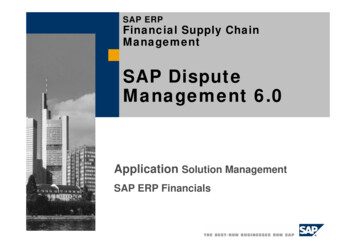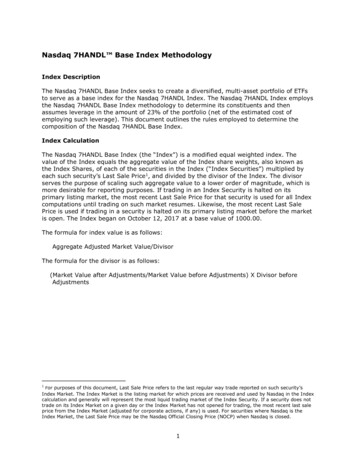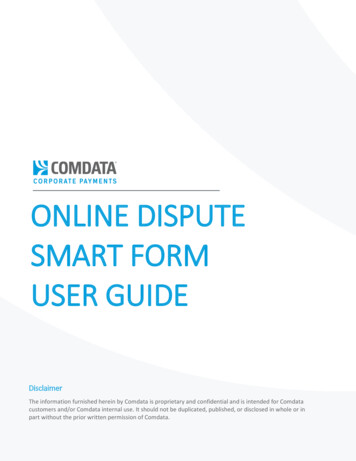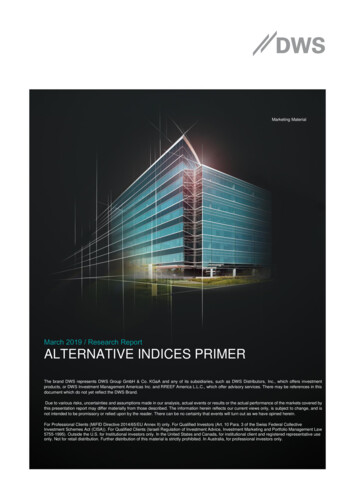
Transcription
First-hand knowledge.Browse the BookIn this chapter, you’ll learn about dispute management functionality inSAP S/4HANA. You’ll see how to create dispute cases manually and automatically, update dispute cases, and monitor dispute cases using keyreports and SAP Fiori apps.“Dispute Management”ContentsIndexThe AuthorChirag ChokshiReceivables Management with SAP S/4HANA623 pages, 2022, 89.95ISBN 978-1-4932-2182-0www.sap-press.com/5408
Chapter 7Dispute ManagementDispute management functions help manage and resolve customerdisputes and prevent them from arising in the future through analysis.This chapter explains the challenges, benefits, and key performance indicators (KPIs) of dispute management with SAP S/4HANA. We’ll walk youthrough dispute business processes and showcase reports and apps forhandling dispute management.7In this chapter, we’ll first explain the importance and business benefits of automatingdispute management processes as well as of integrating these processes with otherreceivables management processes through SAP S/4HANA. We’ll then explain the casemanagement framework for creating dispute cases, including various attributes ofdispute cases and their relevance to business. We’ll present different ways to createdispute cases and then show you how to manage and update dispute cases with subsequent receivables management processes. You’ll also learn about dispute managementreporting through the use of various analytical SAP Fiori apps.7.1 Dispute Management at a GlanceOrganizations with large customer bases and high volumes of transactions must effectively manage their overdue receivables, customer claims, deductions, and disputes tooptimize working capital and enhance customer satisfaction. Your organization’s collections and deductions team must have comprehensive functionality from yourenterprise resource planning (ERP) system. Receivables management in SAP S/4HANAhelps your organization deploy and automate various business processes related tocustomer disputes and the collection of overdue receivables.A customer may raise a dispute at different stages of an order-to-cash cycle, and collection specialists must be informed about pending claims, incorrect prices, product quality/quantity issues, etc., when customers are contacted for overdue invoices or whencustomers simply deduct an amount from a payment. Dispute management processesare important to avoid higher days sales outstanding (DSO), unpredictive cash flows,and higher costs in managing disputes. Efficient dispute management processes helpincrease customer satisfaction by providing credit for valid dispute cases and alsoincrease cash flow by addressing invalid dispute cases.In the following sections, we’ll outline common challenges in and benefits of disputemanagement.311
7Dispute Management7.1.1 Common Challenges and Key DriversOptimizing and reducing DSO is a daunting task for your accounts receivable team.Your accounts receivable and collections team must manage a variety of customer disputes coming from large customer base through various modes, for instance, throughverbal communication from the customer during collections efforts for overduereceivables or in the form of an underpayment notification from a bank.Major challenges include recording and creating customer disputes, processing customer disputes over their lifecycle, and resolving disputes in the form of credit memosto customers for valid disputes, ensuring the collection of overdue disputed amountsfor invalid disputes, etc. Analysis of common causes or the reasons behind customerdisputes can help your organization take corrective action and reduce future disputes.Maintaining the information needed for dispute management-related analytics orreporting is also vital for enhancing the receivables management function.Dispute case processing and resolution may require various downstream processes,such as the ability to write off disputed amounts that cannot be collected, applying acredit memo to a customer to deduct for valid dispute cases, etc., and thus, your systemshould be able to support end-to-end processes. The automation of dispute case creation processing is another aspect that can enhance efficiency in the dispute management function by reducing processing time and ensuring accurate handling of thedispute and clear communication with your customers.7.1.2 Business BenefitsSAP S/4HANA leverages its case management or record management functionality forcreating and processing incidents or cases. Customer disputes are created as disputecases in SAP S/4HANA.SAP S/4HANA provides various attributes for dispute cases to manage them efficiently over their lifecycle, including generating the reporting needed to enhance thereceivables management functions, for instance. SAP S/4HANA provides seamlessintegration between dispute management and other functionalities such as accountsreceivable, collections management, and the general ledger. Additionally, through process integration with accounts receivable, not only can you create dispute cases fromvarious accounts receivable transactions, but you can also enable follow-on processesboth in accounts receivable and dispute management. For example, if a customerraises a dispute for a specific customer invoice, you can put a dunning block on the disputed customer invoice to prevent this invoice from appearing on the next dunningnotice sent to the customer. Similarly, many other follow-on processes, like closingdispute cases through credit memo assignments or payments from a customer for adisputed amount, are enabled in SAP S/4HANA. The SAP S/4HANA system can automatically handle disputes created for short payments or for deductions. For example,you can create dispute cases automatically when importing and processing electronic3127.2Dispute Case Attributesbank statement (EBS) or lockbox files in SAP S/4HANA. Additionally, SAP S/4HANA’sdispute management functionality facilitates the maintenance of electronic recordsand the cascading of information through the record management framework, thusproviding a robust framework for automation and analytics.In summary, SAP S/4HANA provides comprehensive functionalities for the creation,processing, and reporting of dispute cases, which we’ll describe throughout this chapter.77.2 Dispute Case AttributesDispute management in SAP S/4HANA uses SAP’s case management framework for thecreation of dispute cases for any receivables-related issues raised by customers. In thissection, we’ll explore the structure of dispute cases.A dispute case consists of header data with various attributes, linked objects, or relatedinformation; notes attached to the dispute case; and logs. A dispute case’s header datacontains customer or business partner information and attributes about the dispute,such as its status, reason, priority, current processor, processing deadline, etc. as well asvarious amount fields. Linked objects (also called related information, in some SAPFiori apps) contains customers (business partners), dispute invoices (disputed objects),resolved objects (cleared invoices), etc. Linked objects are added, modified, and deletedexclusively through process integration with accounts receivable. Linked objects cannot be changed manually. Additionally, notes can be maintained for each dispute caseto provide further details and information about the dispute case.Figure 7.1 shows the header record of dispute case 10000000012 in the Manage DisputeCases app. Let’s look at the various fields and their significance next:쐍 Case IDThe Case ID is system-generated number for the dispute case.쐍 Case TypeThe Case Type is a central customizing object of SAP S/4HANA and contains variousbuilding blocks, such as the status profile, process integration, and the numberrange of the Case ID field. The value in the Case Type field defaults from the company code assignment.쐍 StatusDispute cases go through different stages during their lifecycle. A dispute case’s status represents the current stage of the dispute case along its lifecycle. Dispute casestatuses are configured in a status profile, which is assigned to the case type. Theoptions available in the Status field be configured according to your company’srequirements. Some possible values include New, In Process, Accepted, To Be WrittenOff, Not Justified, Re-Opened, Closed, and Confirmed.313
7Dispute Management쐍 ReasonThe Reason attribute captures the cause for the customer dispute. Reasons are configured for a Case Type and help in the classification of dispute cases for analysis.Figure 7.1 shows the reasons configured for Case Type YT01. Since dispute case10000000012 was created for a missing quantity, the reason Underdelivery or shortshipment has been assigned.쐍 Root Cause CodeThe Root Cause Code attribute can be configured to capture the root cause thatcaused this dispute case. Usually, Root Cause Code is assigned in a later phase in thedispute resolution process, when the underlying reason for the customer’s disputebecomes known. The difference between a reason and a root cause is that a reasonmight be an Underdelivery or shortshipment (missing quantity) while its root causewould be whatever caused underdelivery. Root cause codes are assigned to the CaseType and are usually blank for newly created dispute cases.쐍 ProcessorThe person indicated in the Processor field works on the dispute case and coordinates efforts with various people within your organization and the customer’s organization for the resolution of the dispute case.7.2Dispute Case Attributes쐍 CoordinatorThe person indicated in the Coordinator field monitors the processing of the disputecase and assigns a processor to the dispute case.쐍 Person ResponsibleThe person indicated in the Person Responsible field is accountable for the resolution of the dispute case. This person is usually a receivables manager and generallyserves as the main contact point if the dispute case is escalated.쐍 Escalation ReasonEscalation reasons can be assigned if a dispute case is escalated to the PersonResponsible.쐍 PriorityThe Priority field is a self-explanatory attribute, and its values are configured for theattribute profile. Usually, the values are low, medium, high, and very high.쐍 Process DeadlineThe date in the Process Deadline field is the planned date for the next step of disputeprocessing.쐍 Planned Closed DateThe date in the Planned Closed Date field is the date by which the dispute case isplanned for resolution and closure.Additionally, various amount fields appear on the dispute case header data such asdispute amount, original dispute amount, credited, paid, automatically written off,cleared manually, etc. We’ll explain various amount fields when they are updated withspecific business processes in accounts receivable, dispute management, etc.We’ll now explain the objects added under different linked objects nodes when a disputecase is created. When a dispute case is created, two obvious linked objects—the customer(business partner) object and the disputed object—are assigned to the dispute case.NoteLinked objects are called related information if the dispute case is displayed in theManage Dispute Cases app.The Manage Dispute Cases app displays a list of dispute cases based on selection filtersand offers drilldown navigation to specific dispute cases. As shown in Figure 7.2 1,you’ll see the Related Information of our newly created dispute case 10000000012. Inthis example, customer 17100001 created a dispute case for invoice 1800000026 ofcompany code 1710. As shown in Figure 7.2 2, the dispute case processor has maintained some notes.Figure 7.1 Dispute Case Header Record314Alternatively, you can use the SAP GUI Transaction UDM DISPUTE to display and process dispute cases. As shown in Figure 7.3 1, click the Linked Objects button to open theLinked Objects section 2.3157
7Dispute Management7.3Dispute Case Processing7.3 Dispute Case ProcessingDispute management in SAP S/4HANA provides functionality for creating disputesdirectly in dispute management as well as for creating disputes through integrationwith other functionalities, such as financial accounting and collections management.The transaction to create and process dispute cases in dispute management is Transaction UDM DISPUTE. In this section, you’ll learn how to create dispute cases throughthis transaction. Additionally, we’ll describe how you can change dispute case attributes and assign finance objects, such as customers and open invoices.7.3.1 Dispute Case CreationFigure 7.2 Manage Dispute Cases: Displaying Dispute CasesFor dispute case processing, Transaction UDM DISPUTE helps you both create disputecases as well as process them. Alternatively, you can follow the IMG menu pathAccounting 폷 Finance Supply Chain Management 폷 Dispute Management 폷 Dispute CaseProcessing. Figure 7.4 shows the top-left portion of Transaction UDM DISPUTE, whichcontains the Cases folder. Expanding the Cases folder shows three options: the DisputeCase, Find Dispute Case, and My Dispute Case folders. Right-click Dispute Case to accesstwo options: Create (for a new dispute case) or Find (for existing dispute cases).Figure 7.4 Transaction UDM DISPUTE: Dispute Case FolderClicking on Create to select the relevant case types. As shown in Figure 7.5, for ourexample, select case type YT01 and press (Enter) to create a new dispute case. The casetype is a central Customizing object in dispute management and controls the structureand properties of the dispute cases. The Case Type is assigned to a company code whenintegrating accounts receivable processes with dispute management. You’ll learnabout case types further in Chapter 8, Section 8.1.12.Figure 7.3 Transaction UDM DISPUTE: Displaying a Dispute CaseAdditionally, notes can be maintained for a dispute case through the SAP Fiori app aswell as in Transaction UDM DISPUTE.316Figure 7.5 Case Type Selection3177
7Dispute ManagementMaintain the attributes of the dispute case, including the Title, Status, Reason, Category, Priority, Processor, and Coordinator fields, as shown in Figure 7.6. After enteringheader attributes, click on Save 1 to create the dispute case.7.3Dispute Case Processing7.3.2 Assigning Financial Accounting ObjectsOnce a dispute case is created through Transaction UDM DISPUTE, the next step is toassign financial objects through the FI Objects button, as shown in Figure 7.8. This button provides three options: Assign Customer, Assign Customer-Disputed Objects, andAdd Open Items. Click on Add Open Items to add disputed invoices to dispute case100000000071.7Figure 7.8 FI Objects for Assigning FinancialAttributes (Customer and Open Items)This option offers selection fields for you to specify the customer and the companycode. For our example, enter customer 17100009 and company code 1710, as shown inFigure 7.9, and then click the Execute icon.Figure 7.6 Header Attributes: Creating a Dispute Case with Transaction UDM DISPUTENow, dispute case 100000000071 has been created, as shown in Figure 7.7. Next, you mustassign additional financial information, such as a customer ID and the disputed invoices.You’ll learn the steps for assigning financial information using FI Objects 2 next.Figure 7.9 Customer and Company Code Selection for Customer Line Item DisplayThis step displays the open items list, as shown in Figure 7.10, for selecting and assigning open items to the dispute case. Select invoice 1800000002 and then click on theCreate Dispute Case button. Now, dispute case 100000000071 has been assigned tocustomer 17100009, and the disputed invoice is 1800000002.Let’s now compare the amount fields of dispute case 100000000071, prior to FI Objectsassignment (shown earlier in Figure 7.7), with the amounts after FI Objects assignment,as shown in Figure 7.11. Notice how the Orig. Disp. Amt (original disputed amount) andDisputed Amounts fields have been updated with USD 5000 after open invoice1800000002 was assigned to the dispute case. Let’s check the Linked Objects sectionand confirm that customer 17100009 and invoice 1800000002 are now updated fordispute case 100000000071. Figure 7.11 also shows assignment of customer, invoice,and disputed amount for dispute case 100000000071.Figure 7.7 Dispute Case 10000000071318319
7Dispute Management7.3Dispute Case ProcessingSAP S/4HANA allows you to create dispute cases from financial accounting both manually as well as automatically, which enhances efficiency in dispute case creation. Creating dispute cases from financial accounting transactions have some inherentbenefits, including the ability to inherit financial attributes from financial accountingtransactions. When using Transaction UDM DISPUTE, you can separately assign financial attributes through the Add Open Items option of the FI Objects button after creating the dispute case.Now, let’s explore two other options for assigning FI Objects: Assign Customer and AddCustomer-Disputed Objects. You’ll also learn how to change existing dispute cases andthen assign financial attributes in change mode. First, go to Transaction UDM DISPUTE, expand the Cases folder, and double-click on Find Dispute Case, as shown in Figure 7.12 1. This step opens the Case Search selection parameters pane in the top-rightportion of the screen. Click on the Search button, as shown in Figure 7.12 2, whichretrieves all dispute cases that meet your selection criteria. The resulting dispute caselist is shown in the bottom-right portion of the screen 3.Figure 7.10 Open Item List for Adding Disputed Open Invoice to a Dispute CaseFigure 7.12 Transaction UDM DISPUTE: Finding a Dispute CaseFigure 7.11 Transaction UDM DISPUTE: Dispute Case 100000000071 after Adding Open Item320Double-click on dispute case 100000000015, which opens the dispute case, as shown inFigure 7.13. Figure 7.13 1 shows the Change/Display button, which toggles the disputecase between change and display mode. Click on the Change/Display button to opendispute case 100000000015 in change mode. Now, the FI Objects button 2 will be activated. On the screen shown in Figure 7.13, the FI Objects button 2 is grayed out (deactivated) but will be activated once dispute 100000000015 is in change mode. Next, let’sassign a customer to the dispute case. Some possible reasons for assigning a customerrather than a customer invoice could be that customer contact may not have invoice3217
7Dispute Managementinformation handy when the dispute is raised or the dispute is not for a specific invoicebut instead relates to the overall credit obligation at the customer account level.Before assigning a customer to the dispute case, as shown in Figure 7.13, you’ll see several amount fields: Orig. Disp. Amt 3, Disputed Amount 4, and Linked Objects 5. Atfirst, the dispute case amount fields will have zero value, and no linked objects exist.Now, click on FI Objects, which opens the options shown earlier in Figure 7.8. Select theAssign Customer option, which opens a screen where you’ll specify a customer and acompany code, as shown in Figure 7.14. Specify customer 17100009, company code 1710,and press (Enter) or click the green checkmark icon. With this step, we’ve assigned customer account 17100009 with dispute case 100000000015.7.3Dispute Case ProcessingCustomer-Disputed Objects options. Both options help you assign customers and disputed invoices, and thus, we won’t cover Add Customer-Disputed Objects to avoidredundancy.7Figure 7.15 Dispute Case 100000000015 after Assignment of Customer 171000097.3.3 Mass Changes to Dispute CasesFigure 7.14 Assigning a Customer and a Company CodeIn change mode, you can update value other fields in dispute headers, including reasons, dates (process deadline dates or planned close dates), processors, coordinators,responsible persons, categories, etc. However, in many instances, multiple disputecases require the same updates, and thus, the ability to mass change multiple disputecases must be enabled. Use Transaction UDM DISPUTE to make mass updates to dispute cases. However, when activating the mass update functionality, SAP providesthe option of configuring which fields are allowed for mass updates and which fieldsare not. The configuration of the case search ID allows you to specify which fieldschanged through mass updates. We explain these configuration steps in detail inChapter 8, Section 8.1.7.Let’s compare dispute case 100000000015 after the assignment of customer 17100009,as shown in Figure 7.15, and before that assignment, shown earlier Figure 7.13. TheLinked Objects section shows customer 17100009 has been assigned to the disputecase. Open invoices in dispute can be assigned later with the Add Open Items or AddExecute Transaction UDM DISPUTE, expand the Cases folder, and then double-click onFind Dispute Case, as shown in Figure 7.16 1. Then, specify selection criteria in the CaseSearch section and execute (Search button 2), which results in a list of dispute cases inthe bottom right. For mass changes to all the dispute cases shown in Figure 7.16, click onSelect All 3, which highlights and selects all the dispute cases.Figure 7.13 Changing a Dispute Case: Adding Customer-Disputed Items322323
7Dispute Management7.4Creating/Displaying Dispute Cases from Financial AccountingThen, click on Change Field Content 4, which opens the fields available for mass changes,as shown in Figure 7.17. In this example, we’ll change the Processor of these disputecases from DISP PROC to REC ACCT.7Figure 7.19 Log of Mass Change to Process Fields of Selected Dispute CaseFinally, processor REC ACCT has been set for dispute cases, as shown in Figure 7.20.Figure 7.16 Mass Changes to Dispute CasesFigure 7.20 New Processor Set to Dispute Cases through Mass Changes7.4 Creating/Displaying Dispute Cases from Financial AccountingFigure 7.17 Mass Changes to Dispute Cases FieldsNow, click on Processor, which will open the screen for specifying a new processor, asshown in Figure 7.18. Enter “REC ACCT” and press (Enter). You’ll see a log of changesmade to the Processor fields of 8 dispute cases, as shown in Figure 7.19.Dispute management is integrated with financial accounting, and this integration isthe backbone to creating and displaying dispute cases through the various transactionsof financial accounting. In this section, you’ll learn the process steps (both SAP Fioriand SAP GUI) for creating dispute cases from documents, customer line items, incoming payments, and bank statements. We’ll also explain the prerequisites for enablingdispute case creation using key apps and transactions.7.4.1 Creating Dispute Cases from Document DisplayThe document display transaction displays an accounting document or journal entry.In this section, you’ll learn how to create a dispute case through the Manage JournalEntries app. Alternatively, you can create dispute cases using Transaction FB03, butwe’ll focus on the SAP Fiori app in this section.Figure 7.18 Mass Changes to Dispute Cases: Specifying a New Processor324You’ll see a selection screen, as shown in Figure 7.21, after double-clicking the SAP Fioritile. Specify selection criteria in the Document Number, Company Code, and Fiscal Yearfields, as shown in Figure 7.21, and press (Enter). This step opens the customer invoicedocument.325
7Dispute Management7.4Creating/Displaying Dispute Cases from Financial AccountingDeadline fields, among others, and then click on Save button. This step creates the dispute case for customer invoice 1800000004.Figure 7.21 Display Journal Entries: Selection Fields7The customer invoice (Document Number 1800000004), shown in Figure 7.22, containstwo line items. The first line item is a debit to customer 17100009, and the second lineitem is a credit posting to the revenue account. Double-click on the customer line item todisplay the line item’s details, that is, the fields and values of the customer line item.Figure 7.23 Customer Line Item of Invoice 1800000004 before Dispute Case CreationFigure 7.22 Display Journal Entries: Displaying Customer Invoice 1800000004As a business process, a customer raises dispute cases for open invoices (i.e., invoicesthat have not been paid). The system also allows the creation of dispute cases only foropen invoices. The system has an inherent control to prevent the creation of disputecase for cleared invoices. If a customer invoice is cleared, you’ll see a clearing documentand a clearing date on the customer line item. The customer line item of invoice1800000004, shown in Figure 7.23, lacks a clearing document or a clearing date, whichmeans this document is an open document. Thus, a dispute case can be created for thisdocument in the SAP system.To create a dispute case, click on More button in the top-right corner, which expands thenavigation menu. Go to Environment 폷 Create Dispute Case.On the Create Dispute Case screen, shown in Figure 7.24, enter details about the disputecase, including maintaining the Title, Reason, Priority, Processor, Coordinator, and Process.326Once the dispute case is created, the Display Journal Entries app provides navigation forviewing the dispute case. Comparing the customer line item before dispute case creation(shown in Figure 7.23) and the customer line item after dispute case creation, as shown inFigure 7.25, notice the Dispute Case button on the header of the customer line item afterthe dispute case is created. Clicking the Dispute Case button opens the existing disputecase on the customer invoice. Figure 7.26 shows dispute case 100000000017, which wehad created for customer invoice 1800000004.NoteTo create or display dispute cases from the Display Journal Entries app or throughTransaction FB03, you must activate Customer-Disputed Objects in the Dispute Casesfunction through when configuring process integration with accounts receivableaccounting. This detailed configuration, explained in Chapter 8, Section 8.2.3, enablesdispute case creation from Transaction FBL5N.327
7Dispute Management7.4Creating/Displaying Dispute Cases from Financial Accounting7Figure 7.24 Display Journal Entries: Dispute Case CreationFigure 7.26 Dispute Case 100000000027 for Invoice 18000000047.4.2 Displaying Dispute Cases in Customer Line Item ReportsCustomer line item reports are available through the Manage Customer Line Items appand SAP GUI Transaction FLB5N. We’ll discuss both options in the following sections.Manage Customer Line ItemsLet’s first focus on the Manage Customer Line Items app report, as shown in Figure 7.27,which is generated with the default Standard layout. The Settings (gear) icon allows youto change the layout by adding fields to the report.Figure 7.25 Customer Line Item of Invoice 1800000004 after Dispute Case Creation328Clicking the Settings icon opens the setting screen, shown in Figure 7.28. Enter “Dispute” into the search bar for a list of dispute management-related fields that you caninclude the layout of your report. For our example, select Dispute ID, Dispute Reason,and Dispute Status and then click OK. The selected fields will be included as columns inthe report layout of the Manage Customer Line Items app, as shown in Figure 7.29.329
7Dispute Management7.4Creating/Displaying Dispute Cases from Financial Accounting7Figure 7.29 Manage Customer Line Items: Dispute Management ColumnsCustomer Line Item DisplayFigure 7.27 Manage Customer Line Items AppDispute cases can be created from the SAP GUI transaction that generates the list ofcustomer line items. To generate the Customer Line Item Display report, follow the SAPIMG menu path Financial Accounting 폷 Accounts Receivable 폷 Account 폷 Display/ChangeLine Items. Alternatively, you can execute Transaction FBL5N.Figure 7.30 shows the selection parameters for the Customer Line Item Display report.For our example, we specified customer 17100001 and company code 1710 for selectionfields under the Customer selection section. In the Line Item selection section, you’llsee three options: Open items, Cleared items, and All items. The default selection forthe report is Open items since usually this report is for displaying customer open itemsthat are due for payment. The Open at key date field has the current date (today). Youcan specify a previous date for a list of historically open items. Similarly, you can specify dates in the Clearing date and Open at key date fields for a selected list of cleareditems.Execute this report for Open items to get the list of open items for customer 17100001for company code 1710. Figure 7.31 shows the open items posted to the customeraccount 17100001. Notice the Create Dispute Case button in this report. Select DocumentNo 1800000019 and then click on Create Dispute Case to create a dispute case.Figure 7.28 Manage Customer Line Items: Dispute Management Fields330331
7Dispute Management7.4Creating/Displaying Dispute Cases from Financial AccountingOnce you’ve entered details into required fields, including the Title, Reason, Priority,Processor, and Process Deadline fields, as shown in Figure 7.32, save the dispute case byclicking the Save icon in the lower right-hand corner. This step creates the dispute case.7Figure 7.30 Customer Line Item Display: Selection FieldsFigure 7.32 Customer Line Item Display: Creating a Dispute CaseIf the Customer Line Item Display report with Transaction FLB5N lacks the required dispute management fields in the layout, execute program RFPOSXEXTEND. This programextends special fields like dispute management fields into the report. Figure 7.33 showsthe message for executing program RFPOSXEXTEND to extend the structure. Usually, dispute management fields have already been extended. However, if dispute management fields are not available with on the Customer Line Item Display report, executethis program to make them available by selecting Yes in the popup window shown inFigure 7.33.Figure 7.33 Executing Program RFPOSXEXTEND to Include Dispute Management FieldsFigure 7.31 Customer
receivables management functions, for instance. SAP S/4HANA provides seamless integration between dispute management an d other functionalities such as accounts receivable, collections management, and the general ledger. Additionally, through pro-cess integration with accounts receivable, not only can you create dispute cases from










